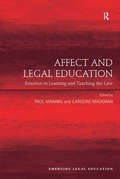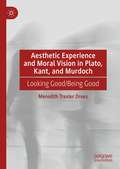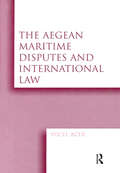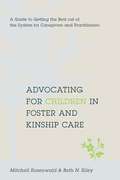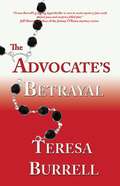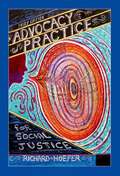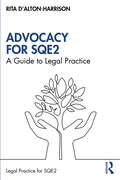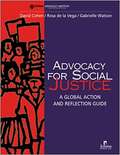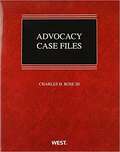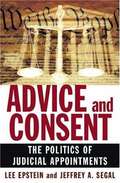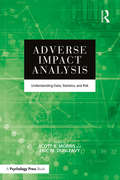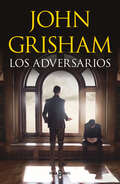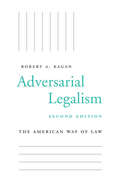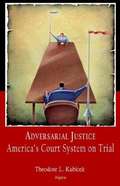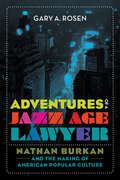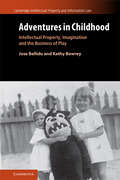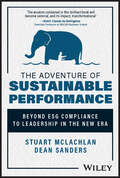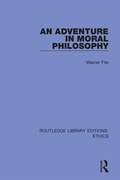- Table View
- List View
Affect and Legal Education: Emotion in Learning and Teaching the Law (Emerging Legal Education)
by Paul Maharg Caroline MaughanThe place of emotion in legal education is rarely discussed or analysed, and we do not have to seek far for the reasons. The difficulty of interdisciplinary research, the technicisation of legal education itself, the view that affect is irrational and antithetical to core western ideals of rationality - all this has made the subject of emotion in legal education invisible. Yet the educational literature on emotion proves how essential it is to student learning and to the professional lives of teachers. This text, the first full-length book study of the subject, seeks to make emotion a central topic of research for legal educators, and restore the power of emotion in our teaching and learning. Part 1 focuses on the contribution that neuroscience can make to legal learning, a theme that is carried through other chapters in the book. Part 2 explores the role of emotion in the working lives of academics and clinical staff, while Part 3 analyses the ways in which emotion can be used in learning and teaching. The book, interdisciplinary and wide-ranging in its reference, breaks new ground in its analysis of the educational lifeworld of situations, communities, actors and interactions in legal education.
Aesthetics and Business Ethics (Issues in Business Ethics #41)
by Daryl Koehn Dawn ElmLudwig Wittgenstein famously said, "Ethics is aesthetics." It is unclear what such a claim might mean and whether it is true. This book explores contentious issues arising at the interface of ethics and aesthetics. The contributions reflect on the status of aesthetic en ethical judgments, the relation of aesthetic beauty and ethical goodness and art and character development. The book further considers the potential role art could play in ethical analysis and in the classroom and explores in what respects aesthetics and ethics might be intertwined and even mutually supportive.
Aesthetic Perspectives on Culture, Politics, and Landscape: Appearances of the Political (UNIPA Springer Series)
by Elisabetta Di Stefano Carsten Friberg Max RyynänenThis book investigates how we are involved in politically informed structures and how they appear to us. Following different approaches in contemporary aesthetics and cultural philosophy, such as everyday aesthetics, atmosphere and aestheticization, the contributions explore how embedded powers in politics, education, democracy, and landscape are analyzed through aesthetics.
Aesthetic Experience and Moral Vision in Plato, Kant, and Murdoch: Looking Good/Being Good
by Meredith Trexler DreesThis book addresses how Plato, Kant, and Iris Murdoch (each in different ways) view the connection aesthetic experience has to morality. While offering an examination of Iris Murdoch’s philosophy, it analyses deeply the suggestive links (as well as essential distinctions) between Plato’s and Kant’s philosophies. Meredith Trexler Drees considers not only Iris Murdoch’s concept of unselfing, but also its relationship with Kant’s view of Achtung and Plato’s view of Eros. In addition, Trexler Drees suggests an extended, and partially amended, version of Murdoch’s view, arguing that it is more compatible with a religious way of life than Murdoch herself realized. This leads to an expansion of the overall argument to include Kant’s affirmation of religion as an area of life that can be improved through Plato’s and Murdoch’s vision of how being good and being beautiful can be part of the same life-task.
Aeronomics and Law: Fixing Anomalies
by Ruwantissa AbeyratneThis book embarks on a contemporary analysis of the interaction of economics and law relating to air transport, delving into the major issues that plague the industry. It shows how some of the thorny and frustrating issues could be approached sensibly. Among the issues discussed are the anomaly of exponential growth of air transport which makes airline profitability continue to be poor; the legislative impediments in most countries that preclude direct foreign investment in the industry; the confounding and muddled mess behind the economics of aircraft engine emissions; and the inexplicable reality that, although civil aviation is primarily meant to meet the needs of the people of the world, State regulators have upended the equation and given priority to national interests over the interests of the passenger. The book will be of interest to economists and lawyers alike who deal with air transport issues, and also to academics and students in the area of transportation as well as regulators and airlines.
Aeronautical Chart User's Guide: Aeronav Products (FAA Handbooks Ser.)
by Federal Aviation AdministrationThe updated 11th edition of the Aeronautical Chart User’s Guide by the FAA is a great reference for novice pilots and professionals alike. Printed in full color with detailed examples, this book provides all the information students and pilots need to know about all the symbols and information provided on US aeronautical charts and chart navigation publications. Readers will find information on VFR charts, aeronautical chart symbols, helicopter route charts, flyway planning charts, IFR enroute charts, explanation of IFR enroute terms and symbols, Terminal Procedure Publications (TPPs), explanation of TPP terms and symbols, airspace classifications, and an airspace class table.
The Aegean Maritime Disputes and International Law
by Yucel AcerThis key work analyses the disputes between Greece and Turkey as to their respective rights in the Aegean Sea, paying particular attention to the claims regarding territorial waters, the continental shelf, and the yet to be declared exclusive maritime zones in the area. While many earlier studies have concentrated on political factors, this study provides an exhaustive analysis of the relevant principles of international law in general and rules and principles of maritime law in particular, identifying the legal principles appropriate to the settlement of the Aegean dispute. With this regard, it makes a detailed examination of all the related aspects of the Aegean Sea and its islands, as well as the legal arguments of Greece and Turkey on the disputes concerned. It also clarifies the prospects for settling the dispute on the basis of international law, either by the two parties involved, or by the intervention of a third party such as the International Court of Justice. As such, it offers an important study of a particular problem, but one that can be used as a case study for other international disagreements.
Advocating for Children in Foster and Kinship Care: A Guide to Getting the Best out of the System for Caregivers and Practitioners
by Mitchell Rosenwald Beth RileyThis book is the first to provide strategies for effective advocacy and placement within the foster care and kinship care systems. It also takes a rare look at the dynamics of the foster and kinship relationship, not just among children and the agency workers and service providers who intervene on their behalf, but also between children and those who take in and care for them as permanency develops. Drawing on their experience interacting with and writing about the institution of foster care, Mitchell Rosenwald and Beth N. Riley have composed a unique text that helps practitioners, foster parents, and relative caregivers realize successful transitions for youth, especially considering the traumas these children may suffer both before and after placement.Advocating for a child's best interests must begin early and remain consistent throughout assignment and adjustment. For practitioners, Rosenwald and Riley emphasize the best techniques for assessing a family's capabilities and for guiding families through the challenges of foster care. Part one details the steps potential foster parents and kinship caregivers must take, with the assistance of practitioners, to prepare themselves for placement. Part two describes tactics for successful advocacy within the court system, social service agencies, schools, and the medical and mental health establishments. Part three describes how to lobby for change at the agency and legislative levels, as well as within a given community. The authors illustrate recommendations through real-life scenarios and devote an entire chapter to brokering positive partnerships among practitioners, families, and other teams working to protect and transition children.
The Advocate's Betrayal (The Advocate Series, #2)
by Teresa BurrellSabre Orin Brown is a legal advocate for children in the San Diego justice system. She witnesses her share of horror every day. Every now and then, that horror gets personal. When Sabre's friend Betty calls one morning with the shocking news that her husband was murdered in his sleep, Sabre makes it her mission to find the killer. The cops suspect Betty, and Sabre has no leads. It would be easier if Betty wasn't hiding something, but even after she gets thrown in jail, she refuses to say a word about her past and the mystery that chased the couple across the country and ultimately hunted her husband to his death. Sabre can't put her own life on hold, either. She is still trying to protect the two children on her caseload whose parents have brainwashed them with a violent racial hatred. Even more, she's also still recovering from the horrific events of the previous year, when a stalker burned her home to the ground. Life never gets easy, but at least Sabre is not alone. She has the comfort of her calm and stable boyfriend, Luke, and the help of good friends. But when a private detective, JP, follows the murder from Betty's empty trailer home to a small town in Texas and a nightclub in Chicago, it starts to seem like finding the answers may be more dangerous than ever. Only one thing becomes remarkably clear: When the people closest to you have so much to hide, you can't trust anyone.
An Advocate Persuades
by Joan Rocklin Robert Rocklin Christine Coughlin Sandy PatrickAn Advocate Persuades introduces its reader to the role of the advocate and the tools of persuasion. This book, like its predecessor A Lawyer Writes, places the reader in the role of a first-year attorney. Now, that first-year attorney must draft a motion or appellate brief and then present an oral argument. With step-by-step explanations and numerous examples, An Advocate Persuades explains how to develop and refine trial-level and appellate arguments and then how to present those arguments orally. Speaking to its readers in a straightforward manner, An Advocate Persuades communicates both the theories and foundational skills of persuasion so that they will be retained for a lifetime of legal practice.
The Advocate (The Advocate Series #1)
by Teresa BurrellSuffering from the mysterious disappearance of her brother five years before, Sabre Brown has handled nearly every case imaginable as a children "s legal advocate. That is, until her partner gives her the easiest case on the roster, advocating for two children taken from their parents after a potentially abusive argument. Sabre's gut tells her there "s more amiss than meets the eye, and her gut is rarely wrong. As she digs into the history of this broken family, Sabre discovers a web of deceit, corruption, and murder that spans the continent.
Advocacy Practice For Social Justice
by Richard HoeferCurrent economic and social forces are creating a society with less equality, justice and opportunity for all but the privileged few. Social workers are called upon by their code of ethics to counteract these trends and actively work to achieve social justice. Hoefer's empirically-based,step-by-step approach demonstrates how to integrate advocacy for social justice into everyday social work practice. The book shows through anecdotes, case studies, examples, and the author's own personal experiences, exactly how advocacy can be conducted with successful outcomes. Each chapter builds upon the previous to provide a concise yet detailed blueprint for conducting successful advocacy. The previous two editions of this book have been used and admired by professors and students alike. Students value its clarity and praise the book for opening their eyes to what they often believed was "the scary and bad" world of politics and policy. After reading the book, they are motivated to become advocates for social justice because they understand how to do so. If you want to empower your students to effect changes in laws, regulations, and other types of policy at all levels, you will find this text the perfect resource to do so.
Advocacy for SQE2: A Guide to Legal Practice (Legal Practice for SQE2)
by Rita D'Alton-HarrisonAdvocacy for SQE2: A Guide to Legal Practice is the first in a new series of books aimed at those preparing for SQE2, providing a comprehensive overview of everything you need to successfully pass the SQE2 advocacy assessment. Split into the two practice sections that candidates may be tested on – dispute resolution (civil) as well as criminal litigation – the book covers the basics of court procedure in both areas, so that you fully understand the role, duties and responsibilities of an advocate. In line with the requirements of SQE2, it also tests the competency skills required of an advocate in legal practice such as planning and organisation, drafting, legal research, presenting a reasoned argument, witness handling, observation, exercising judgment and the application of knowledge and decision-making. It also includes a range of supporting features, including: In Summary sections Key Practice Cases Practice Tips Practice Risks Problem Based Exercises Realistic Case Scenarios Self-Reflection Checklist Further supporting materials are also provided on the companion website. Written by an author with practice experience and early involvement in the planning and development of the SQE itself, this unique book will be essential reading for any candidate wishing to be fully prepared for their SQE2 advocacy assessment.
Advocacy For Social Justice: A Global Action And Reflection Guide
by David Cohen Rosa De la Vega Gabrielle WatsonAdvocacy for Social Justice is the first guide for worldwide social and economic justice advocates. It is a direct and interactive response to the growing need for NGOs to assume new policy advocacy roles. The authors consider why it is essential to build a civil society and nurture democracy as a means of sustaining continued mainstream development. Ideal for practitioners, trainers, or students of activism, the guide uses the elements of advocacy and expounds on current issues using comprehensive case studies.
Advocacy Case Files (Coursebook)
by Charles H. RoseThis text contains two real-world case files reflecting the realities of 21st Century trial practice. Designed from the ground up to challenge and develop a student's advocacy skills and analytical excellence, the text's multiple potential levels of complexity adapt easily for use with any advocacy text. The complete teacher's manual provides a thorough case analysis, suggested assignments, and outcome-driven assessments, enabling the professor to focus on teaching the law, skill, and art of advocacy.
Advice and Consent: The Politics of Judicial Appointments
by Lee Epstein Jeffrey A. SegalFrom Louis Brandeis to Robert Bork to Clarence Thomas, the nomination of federal judges has generated intense political conflict. With the coming retirement of one or more Supreme Court Justices--and threats to filibuster lower court judges--the selection process is likely to be, once again, the center of red-hot partisan debate. In Advice and Consent, two leading legal scholars, Lee Epstein and Jeffrey A. Segal, offer a brief, illuminating Baedeker to this highly important procedure, discussing everything from constitutional background, to crucial differences in the nomination of judges and justices, to the role of the Judiciary Committee in vetting nominees. Epstein and Segal shed light on the role played by the media, by the American Bar Association, and by special interest groups (whose efforts helped defeat Judge Bork). Though it is often assumed that political clashes over nominees are a new phenomenon, the authors argue that the appointment of justices and judges has always been a highly contentious process--one largely driven by ideological and partisan concerns. The reader discovers how presidents and the senate have tried to remake the bench, ranging from FDR's controversial "court packing" scheme to the Senate's creation in 1978 of 35 new appellate and 117 district court judgeships, allowing the Democrats to shape the judiciary for years. The authors conclude with possible "reforms," from the so-called nuclear option, whereby a majority of the Senate could vote to prohibit filibusters, to the even more dramatic suggestion that Congress eliminate a judge's life tenure either by term limits or compulsory retirement. With key appointments looming on the horizon, Advice and Consent provides everything concerned citizens need to know to understand the partisan rows that surround the judicial nominating process.
Adverse Impact Analysis: Understanding Data, Statistics, and Risk
by Scott B. Morris Eric M. DunleavyCompliance with federal equal employment opportunity regulations, including civil rights laws and affirmative action requirements, requires collection and analysis of data on disparities in employment outcomes, often referred to as adverse impact. While most human resources (HR) practitioners are familiar with basic adverse impact analysis, the courts and regulatory agencies are increasingly relying on more sophisticated methods to assess disparities. Employment data are often complicated, and can include a broad array of employment actions (e.g., selection, pay, promotion, termination), as well as data that span multiple protected groups, settings, and points in time. In the era of "big data," the HR analyst often has access to larger and more complex data sets relevant to employment disparities. Consequently, an informed HR practitioner needs a richer understanding of the issues and methods for conducting disparity analyses. This book brings together the diverse literature on disparity analysis, spanning work from statistics, industrial/organizational psychology, human resource management, labor economics, and law, to provide a comprehensive and integrated summary of current best practices in the field. Throughout, the description of methods is grounded in the legal context and current trends in employment litigation and the practices of federal regulatory agencies. The book provides guidance on all phases of disparity analysis, including: How to structure diverse and complex employment data for disparity analysis How to conduct both basic and advanced statistical analyses on employment outcomes related to employee selection, promotion, compensation, termination, and other employment outcomes How to interpret results in terms of both practical and statistical significance Common practical challenges and pitfalls in disparity analysis and strategies to deal with these issues
Adverse Impact Analysis: Understanding Data, Statistics, and Risk
by Scott B. Morris Eric M. DunleavyCompliance with federal equal employment opportunity regulations, including civil rights laws and affirmative action requirements, requires collection and analysis of data on disparities in employment outcomes, often referred to as adverse impact. While most human resources (HR) practitioners are familiar with basic adverse impact analysis, the courts and regulatory agencies are increasingly relying on more sophisticated methods to assess disparities. Employment data are often complicated, and can include a broad array of employment actions (e.g., selection, pay, promotion, termination), as well as data that span multiple protected groups, settings, and points in time. In the era of "big data," the HR analyst often has access to larger and more complex data sets relevant to employment disparities. Consequently, an informed HR practitioner needs a richer understanding of the issues and methods for conducting disparity analyses.This book brings together the diverse literature on disparity analysis, spanning work from statistics, industrial/organizational psychology, human resource management, labor economics, and law, to provide a comprehensive and integrated summary of current best practices in the field. Throughout, the description of methods is grounded in the legal context and current trends in employment litigation and the practices of federal regulatory agencies. The book provides guidance on all phases of disparity analysis, including: How to structure diverse and complex employment data for disparity analysis How to conduct both basic and advanced statistical analyses on employment outcomes related to employee selection, promotion, compensation, termination, and other employment outcomes How to interpret results in terms of both practical and statistical significance Common practical challenges and pitfalls in disparity analysis and strategies to deal with these issues
Los adversarios
by John GrishamTres emocionantes historias del maestro Grisham con el mundo de la ley como hilo conductor. «Vuelta a casa» nos lleva de regreso a Ford County, escenario de muchas de las inolvidables historias de John Grisham. Esta vez Jake Brigance no está en el tribunal; quien acude a él es un viejo amigo, Mack Stafford, un exabogado de Clanton. Tres años antes, Mack se convirtió en una leyenda local cuando robó el dinero de sus clientes, se divorció de su mujer, se declaró en bancarrota y abandonó a su familia en mitad de la noche sin que nunca más se volviera a oír hablar de él... hasta ahora. Mack ha vuelto y confía en sus viejos colegas para que le ayuden. Pero su regreso no resulta como lo había planeado. En «Luna de fresa», Cody Wallace, un joven preso, se encuentra en el corredor de la muerte a solo tres horas de su ejecución. Sus abogados no pueden salvarle, el tribunal le ha cerrado sus puertas y el gobernador se ha negado a una última petición de clemencia. Mientras el reloj avanza, Cody tiene una última petición.Los adversarios está protagonizado por los hermanos Malloy, Kirk y Rusty, dos ambiciosos y exitosos abogados que heredaron un próspero bufete cuando el fundador, su padre, fue enviado a prisión por el asesinato de su mujer. Kirk y Rusty se aborrecen y solo se hablan cuando es estrictamente necesario, y el bufete se encuentra en plena decadencia y a punto de desintegrarse. Y ahora que su padre podría salir de la cárcel antes de lo esperado..., el enfrentamiento entre los Malloy parece inevitable. La crítica ha dicho:«La obra de Grisham -siempre un entretenimiento excelente- está evolucionando a algo más serio, más poderoso, más merecedor de su excepcional talento».The Washington Post «Estas tres historias en un solo volumen muestran a un Grisham en su mejor momento... Una pequeña obra maestra».Daily Mail «El mejor autor vivo de thriller».KEN FOLLETT«John Grisham es uno de los mejores escritores que tenemos en Estados Unidos en estos momentos».The New York Times «Tres chispeantes historias de Grisham por el precio de una... Un fantástico entretenimiento».Irish Independent
Adversarial Legalism: The American Way of Law, Second Edition (California Series In Law, Politics, And Society Ser. #1)
by Robert A. KaganAmerican dispute resolution is more adversarial, compared with systems of other economically advanced countries. Americans more often rely on legal threats and lawsuits. American laws are generally more complicated and prescriptive, adjudication more costly, penalties more severe. Here, Kagan examines the origins and consequences of this system.
Adversarial Justice: America's Court System on Trial
by Theodore L. KubicekOh, those lawyers! <P><P>The legal profession in fact, the legal system certainly has a poor reputation in the United States. Proposed remedies, however, rarely go as deep as the ethics of the system. America's judicial system should not be a game that anyone can win, regardless of actual guilt or liability. Ted Kubicek, JD, describes the problems and proposes solutions. Above all, he condemns the adversary system of justice which is used to evade the truth and which makes winning the paramount goal. <P><P>Dr. Kubicek postulates that the attorney-client privilege of communication makes the truth more difficult, even impossible, to determine. The adversary system goes hand in hand with the privilege of communication since neither can exist without the other. <P><P>He advocates moving instead to an inquisitorial system, in which truth is the goal of both parties, not just of the party that would gain thereby. He then shows how the elimination of adversaryism would automatically remedy other problems endemic to the system of justice, too, such as the passiveness of trial judges and juries. <P><P>Scrapping the adversary system would abolish trial and pretrial procedures and evidentiary rules that confuse law enforcement and trial participants alike. Criminal verdicts would not then depend upon confusing evidentiary or technical matters having no connection to the guilt or innocence of the accused. <P><P>This book is intended to encourage the legal profession, the judiciary, and the organized bar to remedy America's counter-productive judicial procedures. The argument will also interest anyone who has ever had to go to trial.
Adventures of a Jazz Age Lawyer: Nathan Burkan and the Making of American Popular Culture
by Gary A. RosenAdventures of a Jazz Age Lawyer is the lively story of legal giant Nathan Burkan, whose career encapsulated the coming of age of the institutions, archetypes, and attitudes that define American popular culture. With a client list that included Charlie Chaplin, Al Jolson, Frank Costello, Victor Herbert, Mae West, Gloria Morgan Vanderbilt, Arnold Rothstein, and Samuel Goldwyn, Burkan was “New York’s Spotlight Lawyer” for more than three decades. He was one of the principal authors of the epochal Copyright Act of 1909 and the guiding spirit behind the American Society of Composers, Authors, and Publishers (Ascap), which provided the first practical means for songwriters to collect royalties for public performances of their works, revolutionizing the music business and the sound of popular music. While the entertainment world adapted to the disruptive technologies of recorded sound, motion pictures, and broadcasting, Burkan’s groundbreaking work laid the legal foundation for the Great American Songbook and the Golden Age of Hollywood, and it continues to influence popular culture today.Gary A. Rosen tells stories of dramatic and uproarious courtroom confrontations, scandalous escapades of the rich and famous, and momentous clashes of powerful political, economic, and cultural forces. Out of these conflicts, the United States emerged as the world’s leading exporter of creative energy. Adventures of a Jazz Age Lawyer is an engaging look at the life of Nathan Burkan, a captivating history of entertainment and intellectual property law in the early twentieth century, and a rich source of new discoveries for anyone interested in the spirit of the Jazz Age.
Adventures in Childhood: Intellectual Property, Imagination and the Business of Play (Cambridge Intellectual Property and Information Law #61)
by Jose Bellido Kathy BowreyAdventures in Childhood connects modern intellectual property law and practice with a history of consumption. Structured in a loosely chronological order, the book begins with the creation of a children's literature market, a Christmas market, and moves through character merchandising, syndicated newspaper strips, film, television, and cross-industry relations, finishing in the 1970s, by which time professional identities and legal practices had stabilized. By focusing on the rise of child-targeted commercial activities, the book is able to reflect on how and why intellectual property rights became a defining feature of 20th century culture. Chapters trace the commercial empires that grew around Alice in Wonderland, Peter Rabbit, Meccano, Felix the Cat, Mickey Mouse, Peter Pan, Eagle Magazine, Davy Crockett, Mr Men, Dr Who, The Magic Roundabout and The Wombles to show how modern intellectual property merchandising was plagued with legal and moral questions that exposed the tension between exploitation and innocence.
The Adventure of Sustainable Performance: Beyond ESG Compliance to Leadership in the New Era
by Dean Sanders Stuart McLachlanA guidebook for leaders to create value from sustainability and organisational performance. The Adventure of Sustainable Performance seeks out bold pioneers or forgotten pioneers who need reinvigorating and to be inspired with renewed purpose. Leaders who want more than just modest incremental efficiency gains, who want to create value, to deliver positive impact and meaningful change, should welcome this book. In a time of disruption like never before, boundaries will need revisiting, systems need reimagining, and assets need repurposing through wise stewardship. The authors share their many years of experience serving clients and driving performance as the world transitions to a net zero carbon future. A future that uses resources sustainably and that seeks social justice. Through storytelling and interviews from many international leaders in business and sustainability, and by anchoring practical advice with evidence and truth, you will find: The avalanche of new regulations and changes to the compliance landscape The opportunity for value creation beyond compliance box ticking Inspirational stories on how ambitions can be reset A destination that supports ongoing prosperity for humanity from sustainable performance models How purpose driven brands generate superior value The role of ‘Total Value Systems’ as we move from shareholder to stakeholder capitalism models. The relationship between sustainability, talent and customer attraction How digital will play an increasingly important role as the world pivots in response to the climate crisis Be in no doubt, The Adventure of Sustainable Performance describes an adventurous journey, uncomfortable at times, where a new and cold reality is dawning. But, in a period when the world will continue to play at denial or talk more of ruins, this book helps leaders to instead see foundations. Foundations upon which the new era will be built, and new systems of value will be realised. Perfect for executives, managers, directors, and other business leaders, The Adventure of Sustainable Performance is an actionable guidebook for the implementation of value-add sustainability programmes.
An Adventure In Moral Philosophy
by Warner FiteOriginally published in 1926, this book develops the Socratic thesis that morality is intelligence, that morality is not a matter of standards, laws and principles but in knowing what we do – in living self-consciously. The book develops this central theme in its bearings upon logic and science, art and religion and suggests that both intelligence and morality stand for much more than appears first obvious.
